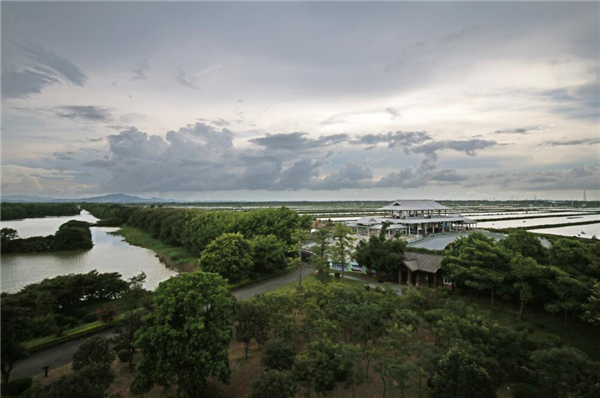Nansha Wetland Tourism Zone

Birds flying in Nansha Wetland Park. [Photo/ nssd.com]
Nansha Wetland Park makes Nansha the optimal place to watch birds in Guangzhou.
Located at the southernmost tip of Guangzhou, on the west bank of the Pearl River, Nansha Wetland Tourism Zone has a total area of around 10,000 mu.
The wetland was formed from a crisscross network of watercourses where mangroves vigorously grow on the green water, ruffled by the breeze in a picturesque scene. Over 100,000 migratory birds fly in from the north to spend the winter here every year, feeding, resting and breeding. According to a survey of South China Endangered Wildlife Protection Institute, there were 148 bird species here in 2010, with wild ducks in flocks and Grey Heron standing on the water, making Nansha Wetland a bird sanctuary of Guangzhou and the Pearl River Delta.
Nansha Wetland was artificially formed. In the 1980s, the enclosing seashore and development enterprises worked hard to retain the features of traditional agriculture and fishing sectors, as well as the original conditions of the land enclosed. Mangroves and reeds they planted and aquatic products they cultivated gradually began to create a wetland here. In the 1990s, people gradually realized the importance of consciously renovating the wetland, and an administrative organ of the wetland sight-seeing zone was established in 1995. The facilities were then continuously perfected and the amount of mangroves increased. The investment for the restoration and protection of the wetland and tourist development program has been on the increase each year. In the end, the vision for a harmonious scene between humankind and Mother Nature came into existence. The tourism zone officially opened doors for business in 2008.

Distant view of Nansha Wetland Park. [Photo/ nssd.com]
The park grows mangroves to maintain an ecological balance. With thousands of mu of reed, marshes have been formed with large stretches of ornamental lotus presenting a grand scenery. There is a 25-mile-long river with twists and turns, just like a maze of water. In the park, tourists can appreciate the beautiful scenery of the twisting river and reed marshes, stretches of lotus and thousands of birds in the mangroves.
Lotus blooms from March to July and is the prettiest in June and July. September and October are the two optimal months for reed growth.
When one travels the wetland by boat, one will go through several areas. First one passes through the foraging area of migratory birds where they search for sea fish, then the lotus area, reed area and finally the mangroves. The whole journey takes 40 minutes. For the sake of the wetland, traveling by boat is open for five hours each day, and only two to three boats at a time. If you wish to take such a tour, please book it in advance. The telephone number for bookings is 020-84951083.
There are bikes for rent for the convenience of tourists. As you can only travel along the edge of the park by bike, boats are recommended, allowing you to fully enjoy the wetland landscape.
Address: Shibachong Canal, Wanqinsha town, Nansha district
Website: www.nssd.com.cn



